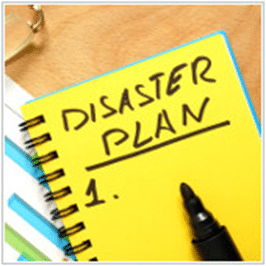
We all know that unpredictability is a fact of life. Hurricanes and tropical storms, wildfires and other major disasters are a grim and unfortunate lesson for many overconfident business owners who think their companies will be spared from cataclysmic weather, technological malfunctions, or human actions.
A 2014 survey by the IT Disaster Recovery Preparedness (DRP) Council revealed that 73 percent of SMBs worldwide fail in terms of disaster readiness. What does this mean? It means that three out of four companies aren’t prepared to handle emergencies and save their businesses from a worse-case scenario. However, companies that do put a business continuity and disaster recovery plan into place can save years of business loss. This introductory primer will help you decide if DR is right for you.
What is Business Continuity and Disaster Recovery (BCDR)?
Business Continuity and Disaster Recovery is a plan for restoring and accessing your data in the event of a disaster that destroys part or all of a business’s resources. It is a key component, involving many aspects of business operations that require specific data in order to function. The job of a BCDR plan is to ensure that whatever happens, your vital data can be recovered and mission-critical applications will be brought back online in the shortest possible time.
What kind of disasters are likely to happen?
Business disasters can be natural, technological, or man-made. Natural disasters include floods, earthquakes, tornadoes, hurricanes, landslides, tsunamis, and even pest infestations. Technological and man-made disasters involve hazardous material spills, infrastructural or power failure, nuclear power plant meltdowns or blasts, chemical threats and biological weapons, cyber attacks, explosions, or acts of terrorism and civil unrest.
Why does your business need BCDR?
Regardless of industry or size, when an unforeseen event takes place and causes day-to-day operations to come to a halt, a company will need to recover as quickly as possible to continue providing services to clients and customers. Downtime is one of the biggest IT expenses that any business can face. Based on 2015 disaster-recovery statistics, downtime that lasts for one hour can cost small companies as much as $8,000; mid-size organizations $74,000; and large enterprises $700,000.
For SMBs particularly, any extended loss of productivity can lead to reduced cash flow through late invoicing, lost orders, increased labor costs as staff work extra hours to recover from the downtime, missed delivery dates, and so on. If major business disruptions are not anticipated and addressed today, it’s very possible that these negative consequences resulting from an unexpected disaster can have long-term implications that affect a company for years. By having a Disaster Recovery plan in place, a company can save itself from multiple risks including out-of-budget expenses, reputation loss, data loss, and the negative impact on clients and customers.
How do I create a DR strategy for my business?
Creating, implementing and maintaining a total business recovery plan is time consuming but extremely important to ensure your business’s survival. Many organizations don’t have the time or resources to dedicate to this process.
Contact our Network Services division to learn how to implement a BCDR plan and protect your business from unexpected disasters.
[fc id=’34’][/fc]
